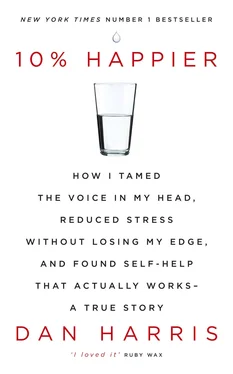I wait my turn in line, load up a plate, and suddenly find myself in one of those awkward, high school cafeteria–type situations, in which I don’t know where to sit. There are around one hundred of us. The crowd consists overwhelmingly of white baby boomers. A lot of these people seem to know one another—they must be regulars on the West Coast meditation scene. Since we haven’t yet been told that we have to stop talking, everyone’s kibitzing happily.
I find a spot next to a kindly, older married couple, who strike up a conversation. I express my fears about the first few days being brutal. The wife reassures me, saying it’s not that bad. “It’s like having jet lag,” she says.
As we finish eating, Mary, the head chef—a chipper, cherub-faced woman with short brown hair—gets up and makes a little presentation. There will be three meals a day: breakfast, lunch, and a light supper. There are rules: no food in the rooms; no entering the dining hall until invited in by one of the chefs, who will ring a bell; after eating, we must line up, scrape off our plates, and put them in plastic tubs for the kitchen cleaners. For hard-core vegans, there’s a special side area of “simple foods.” And for people who really have special dietary needs, there’s a “yogi shelf,” where they can keep their personal stash of wheat germ or whatever. Mary has none of the severity I was expecting. I had pictured a Buddhist Nurse Ratched. “I want you to think of this as your dining room,” she tells us, and she seems to actually mean it.
The official opening session is held in the meditational hall, located in a stately building on an outcropping of rock set apart from the dorms by a hundred yards or so. Before entering, everyone takes off their shoes in a little foyer. The hall is large and airy, with shiny wood floors and lots of windows. There’s an altar at the front with a statue of the Buddha. Arrayed before it are roughly a dozen mats in neat rows. Many people have shown up early to claim their spots and have built elaborate meditation nests out of small wooden benches, round cushions called “zafus,” and thin, wool blankets. They’re sitting, with legs crossed and eyes closed, waiting for the proceedings to begin. This sends my “comparing mind” aflutter. I’m clearly out of my league.
For those of us who can’t hack the traditional postures, there are several rows of chairs lined up behind the mats. So, much as I’d done as a sullen punk kid in high school, I find myself sitting in the back of the room.
As soon as I’m settled, I look over to see a row of teachers walking into the hall, single file. They’re all silent and stone-faced, with Goldstein bringing up the rear. I recognize him from the pictures on his book jackets. He’s taller than I expected. He walks in long, slow strides. He’s wearing a button-down shirt and khakis that ride high on the waist. There’s a roughly three-inch strip of baldness down the center of his head, flanked by short brown hair on either side. The centerpiece of his angular face is a large, elegant protuberance of a nose. He’s wearing a goatee. He looks very, very serious. The overall effect is a little intimidating.
The teachers take their seats in the front row and one of them, a fiftyish Asian woman named Kamala, welcomes us in that artificially soft, affected manner of speech that I’m now thinking they must teach at whatever meditation school these people attended. She formally opens the retreat and declares that we have now officially “entered into silence.” More rules: no talking, no reading, no sex. (I’ve read that there’s such a thing as a “yogi crush,” a silent longing for one of your fellow meditators, at whom you steal furtive glances and around whom you construct feverish fantasies. As I look around the room, I realize this will not be a problem for me.)
In her contemplative purr, the teacher tells us that the goal on retreat is to try to be mindful at all times, not just when we’re meditating. This means that all of our activities—walking, eating, sitting, even going to the bathroom—should be done with exaggerated slowness, so we can pay meticulous, microscopic attention.
At this point, I get my first look at the schedule we will be following for the rest of the retreat. It’s even more brutal than I’d imagined. The days will start with a five o’clock wake-up call, followed by an hour of meditation, then breakfast, then a series of alternating periods of sitting and walking meditation of various lengths, lasting all the way up until ten at night, broken up by meals, rest and work periods, and an evening “dharma talk.” I do some quick math: roughly ten hours a day of meditation. I honestly do not know if I can hack this.
Day Two
My alarm goes off at five and I realize, suddenly and unhappily, where I am.
I pick out one of the three pairs of sweatpants I packed in anticipation of long, sedentary days. I pad down the hall to the bathroom, perform the ablutions, and then walk outside into the chilly morning air and join the stream of yogis heading out of the dorms into the meditation hall. Everyone’s walking slowly, with heads down. I realize that these people are really taking seriously the injunction to be mindful at all times.
As I walk amid the silent herd through the predawn darkness, I resolve to go balls-out on this retreat. If I’m going to do this thing, I’m going to do it right, damn it.
So, when I enter the hall, instead of going to the chair I’d picked out the night before, I wade into the archipelago of mats. I put two cushions on top of each other and straddle them, imitating the sitting style of some of the more experienced meditators.
I notice that as people file in, many of them stop and bow in the direction of the Buddha statue at the front of the hall. This makes me uncomfortable. I wonder how Sam deals with this.
Then another unpleasant surprise: There are pieces of legal-size paper at each of our meditation stations. They are lyric sheets. We will be expected to chant.
One of the teachers, a middle-aged white guy, takes the podium and explains that these are the “Refuges and Precepts,” the chants with which yogis have, for centuries, started their day. The lyrics are in Pali, the language of the Buddha, but they’re spelled out for us phonetically. He begins chanting, slow and low, and the rest of us join in, reading from our sheets. (Chanting is one of the only exceptions to the “Noble Silence” rule, along with the occasional opportunity we’ll get to speak with the teachers.)
On the right side of the page is the English translation. In the first part of the chant, we’re “taking refuge” in the Buddha, “the Blessed One, the Perfected One, the Fully Enlightened One.” Then we take the “precepts,” which are basically a series of promises: no harming (people or animals), no stealing, no lying, no substance abuse—and also, as if this might be a problem, “no dancing, singing, music, and unseemly shows.” If my friends could see me perched on this tuffet, chanting, they would be laughing their asses off.
When the chant ends, we’re off—we’re meditating. This is it. Game on.
Almost immediately, I realize that sitting on cushions is a terrible idea. I am assailed by back and neck pain. The circulation to my feet feels like it’s dangerously choked off. I try to focus on my breathing, but I can’t keep up a volley of more than one or two breaths.
In.
Out.
In.
Holy crap, I think my feet are going to snap off at the ankle.
Come on, dude.
In.
It feels like a dinosaur has my rib cage in its mouth.
Out.
I’m hungry. It’s really quiet in here. I wonder if anyone else in here is freaking out right now.
Читать дальше












